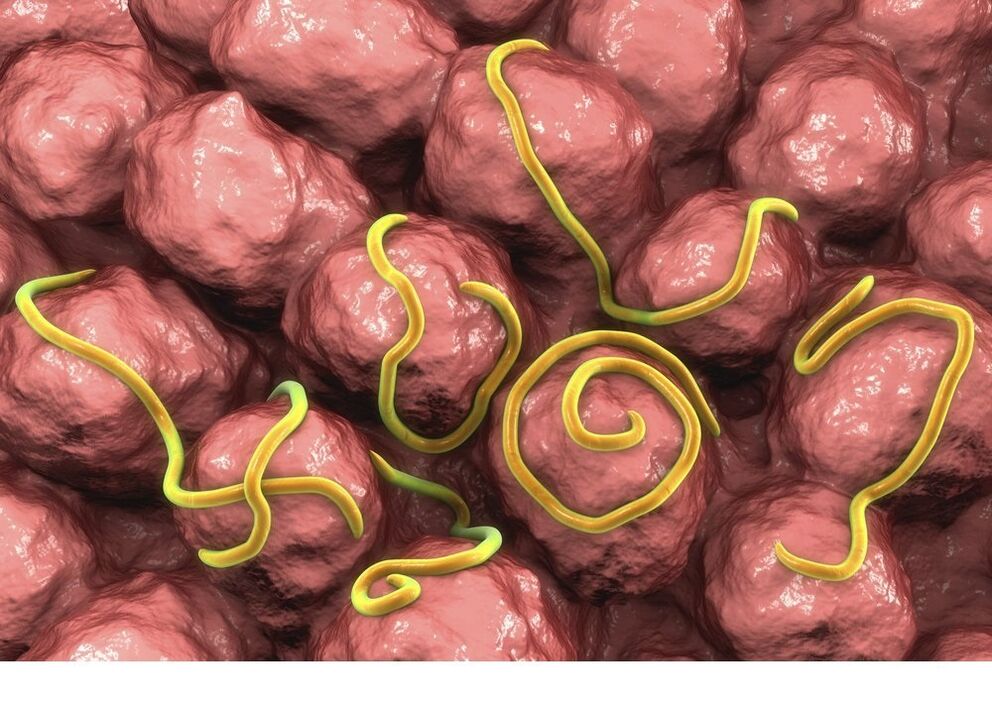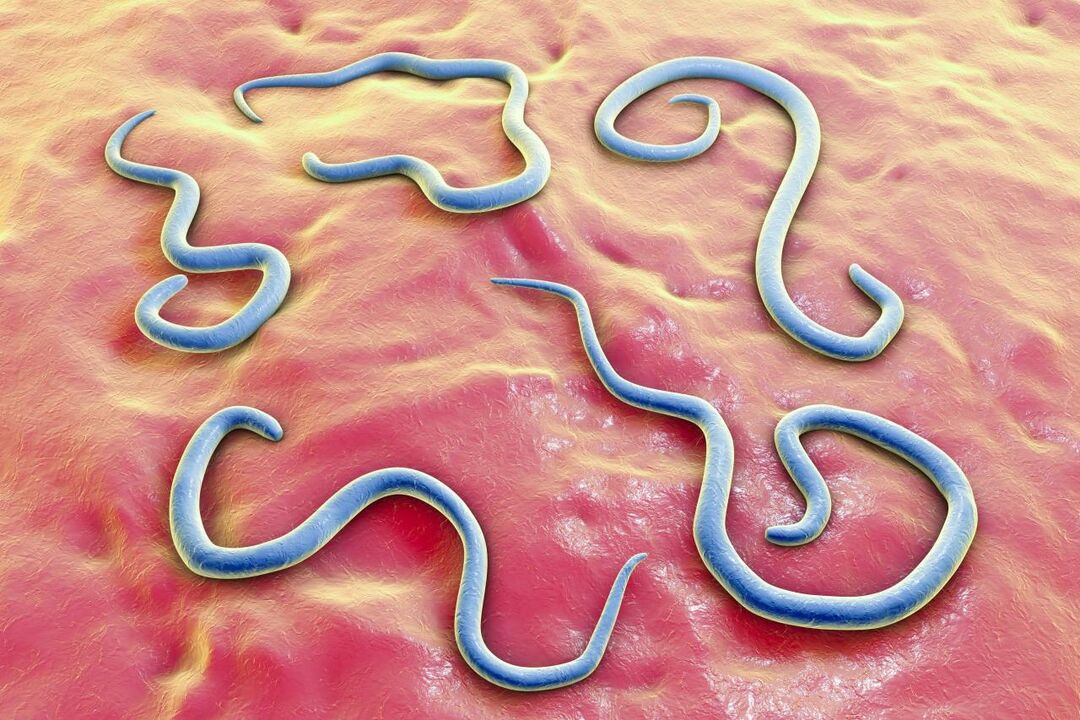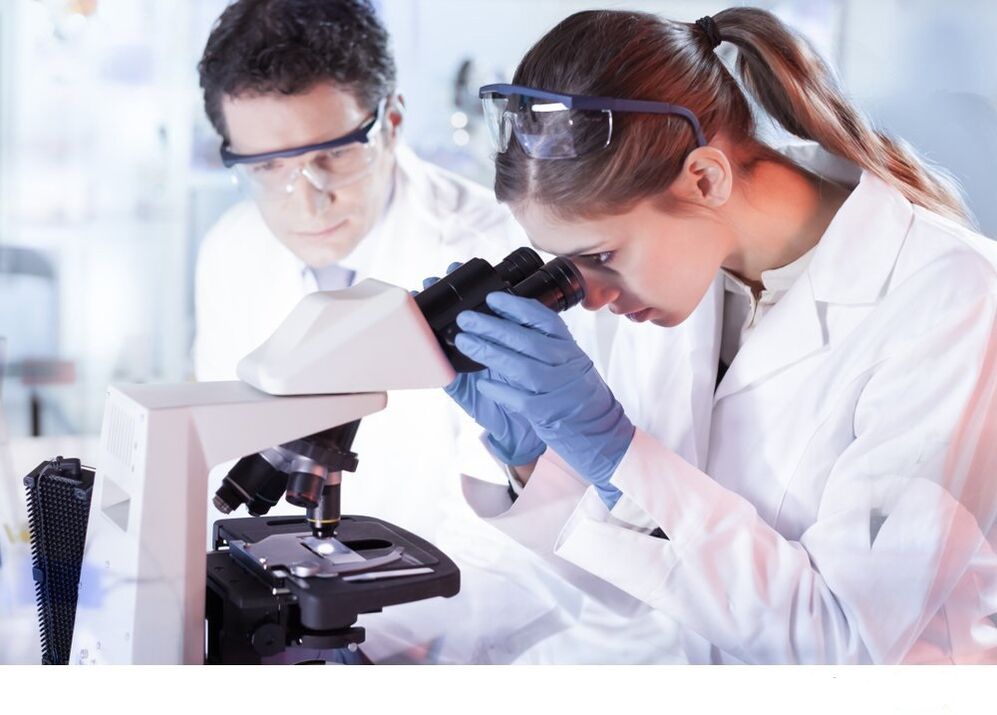Helminths, or diseases caused by helminths, are among the most common in humans. According to rough estimates by experts from the World Health Organization, every fourth person on the planet is infected with one or another helminth. And it comes as no surprise, because you can get this infection almost anywhere in the world. Doctors equate the impact of helminthiasis with the spread of the flu and ARVI.
Doctors estimate that the scale of worm infection in our country is 270 cases per 100 thousand of the population, but the actual incidence, according to experts, is several times higher. This is because often a person does not even notice that a guest has been installed in his body. If helminths do not manifest in any way, then the disease can remain undiagnosed for decades.
All about helminths
Parasitic worms, helminths or worms?
This huge group of living things has many names at once. First of all, we are talking about parasites, that is, living organisms that live at the expense of others. In addition, we are talking about endoparasites, that is, living inside another organism - in its tissues and organs. Finally, we are talking about worm-like creatures, which are ideally adapted to live long in the body of an infected animal and reproduce efficiently.
Consequently, helminths are parasitic worms. The very term "helminths" was once introduced by Hippocrates. Among humans, these nasty creatures are also called worms - from the ancient Greek word, which simply means a parasitic worm.
So when talking about helminths, we will not be wrong in saying worms or parasitic worms. And if we talk about helminthiasis, these diseases can also be called "parasitic infections".
A variety of helminths in humans

In total, scientists know about 287 types of helminths that can parasitize humans. In our country, only 65 species have been identified and only 24 species are among the most common.
Worms in humans live all over the body and each species has its own preferences.
Basically, worms prefer the gastrointestinal tract and especially the small intestine, in which you can find roundworms, pinworms, three varieties of tapeworms, wide tapeworms, hookworms, etc. Vlasoglav occupies only the large intestine.
In the liver, more specifically in its bile ducts, as well as in the gallbladder, vesicles, hindquarters, etc. can be found. The lung is located in the lungs. Trichinella affects the muscles. Adult pork strips live in the small intestine and larvae (cysticercus) are found in the eyes and central nervous system. Schistosomes (helminths from the tropics) prefer the veins of the gastrointestinal tract and urinary tract.
Filariae are generally ubiquitous - they can be found in the lymphatic system and closed body cavities - in the retroperitoneal space, pericardial sac and their larvae are usually found in the blood or skin.
Types of helminths that live in humans
Helminths, the species of which are most interesting to doctors, are divided into two main types: flat and round (nematode). The classification is based on the cross section of the worm body: in roundworms it has the shape of a circle and in flatworms it is straightened in the direction from the conditional back to the conditional abdomen. Flatworms are further divided into two categories: flukes (trematodes) and tapeworms (cestodes).
- Nematodes. Most nematodes are inhabitants of the human gut. This group includes worms, worms, Trichinella, whipworms, etc. , very different from each other in size - from a few millimeters to 1. 5 meters. They all have their own well-developed digestive system. Nematodes have men and women. It is not difficult to distinguish them in adults: females are usually doubled and, in addition, in males, the "tail" turns to the "belly".
- Trematoid. The body of the trimmings looks like a leaf or a scalpel in shape and can not be compared in size with other helminths: these are small worms, from a few millimeters to 3, 5-5, 5 cm long. Unlike worms, crumbs have a fermenter in the mouth and abdomen. Their digestive system is in the womb. An important part of the species of this group are the hermaphrodites, ie they combine the characteristics of both sexes. The exception is schistosomes, which have both men and women.
- Estonia. The codes are worms, which are a long strip fragmented into small sections, at one end of which there is a head with hooks and hoods. These worms live exclusively in the small intestine - their whole body does not fit into any other organ. And this is not surprising, because the length of the films can reach 10-11 meters. They do not need a digestive system at all, as they absorb everything they need from the food a person eats. All films are hermaphroditic.
The organism in which the larvae live in the larval stage is called the intermediate host (it can be animals, fish, mollusks and, of course, humans), and the adult form vector is called the final host.
Depending on whether a given type of worm has a developmental stage in the body of a vector, they also speak of bio- and geohelminthiasis.
- Geohelminths do not have such a scene. The worm eggs fall to the ground, where they wait until, by the will of fate, to be transferred to the body of the future owner. Geohelminths includes whipworms, roundworms, hookworms etc.
- Biohelminths have such a stage and there may be several hosts. Examples include Trichinella, strips, schistosomes, all flatworms, etc.
Some scientists now, with the mechanism of transmission, distinguish a third group of worms - contagious helminths, which include pins (geohelminths) and dwarf strips (biohelminths). These parasites spread in contact with an infected person.
In addition, depending on which hosts play a key role in the life of the helminths, anthropoids and zoonoses are isolated.
- The first category includes helminthiasis, in which a person is a mandatory stage of his life cycle: ascariasis, enterobiasis, etc.
- Zoonoses include helminths, the causative agents of which can exist successfully without a person, but at the same time our species is also sensitive to them, and if infection occurs, then the worms will not affect life and well-being. This category includes historhiasis, bisexuality, etc.
How does helminth infection occur?
Most of the time, people are infected with worms, to speak orally, that is, to swallow helminth eggs. The most striking example is the worms, the eggs from which a child can pick up in a sandbox (a way of contact-spread of infection) The food path (through food) is characteristic of worms - through infected vegetables or fruits andtremors that enter the body when they eat contaminated but poorly cooked seafood or meat etc.
However, food is not the only route of helminth infection. Eggs can enter the human body through the inhalation of dust. Both hooks and schistosomes enter the body through the skin - and are called contagious worms, and the route of infection is transdermal. And since schistosomes can be collected while swimming in a lake, this route of infection is also called aquatic.
In the tropics, the nematode plant lives, it is also the wuchereria, which spreads with the help of a mosquito bite. And this is a carrier of infection.
Infection with helminths can also occur through contact with animals - infected cats and dogs. Usually, people get worms (toxocar, etc. ) and animal strips. Pets, during the licking process, carry helminth eggs through their fur. A person who has petted such an animal and does not wash his hands immediately afterwards is at risk of injecting an infection into his mouth. Another option for worm infestation is to clean the trash can without gloves.
How do helminths affect the body?

Mechanical impact
This category includes any helminth actions that violate the integrity of the host tissues. For example, adult helminths with hooks and suction cups are attached with their help, while destroying the gastrointestinal mucosa. As a result, tissue erosion develops in the area where the worm is located, ulcers form and the nutritional processes of the mucous membrane are disrupted, which can even lead to its death (necrosis).
By moving the body, the so-called migratory larvae can also cause bleeding and inflammation in the damaged areas - this makes it easier for them to penetrate deep into the tissues. And helminths in the intestines often cause appendicitis, intestinal obstruction and even rupture.
Finally, the bladder, which has entered the brain and is actively growing there, compresses the tissues, which can lead to the death of a person.
Reception malnutrition
First, the helminths themselves "rob" their host, consuming the food they have eaten. Second, some human helminths feed on the blood itself - this is what hookworms and whips do, or they get the substances they need to bleed. Therefore, in the context of a parasitic infection, anemia may develop.
With prolonged chronic helminth infection, which absorbs metabolically valuable nutrients, protein-calorie deficiency is diagnosed.
Poisoning of the human body with helminth toxins
The metabolic products of the whip and tapeworm destroy red blood cells and secretions of ascaris cause capillary dilation and, as a result, bleeding.
Some parasitic worms begin to pose an increased risk after death, releasing substances with necrotic and hemotoxic properties.
Allergy to helminth proteins
Helminths are extraterrestrial organisms for us, so our body perceives many proteins secreted by them (in the process of vital activity or after death) as a potential danger and may consider them as antigens. During sensitization to these antigens, antibodies - IgE and IgG-4 immunoglobulins - are formed. These antibodies, when they come in contact with mast cells, basophils and eosinophils, cause their destruction. At the same time, there is a release of substances that cause allergic reactions (mediators of allergy) - histamine, serotonin, heparin, etc.
Suppression of the body's defenses
The negative effect of helminths on the body can be indirect. The bands, which are located, as mentioned above, in the small intestine, can cause a decrease in gastric acidity. And this significantly reduces the protection against the penetration of pathogenic bacteria in the body.
Many helminths have immunosuppressive properties, ie they suppress the body's defenses, thus ensuring a comfortable existence for a long time. It is an evolutionary adaptation that they acquired during their adaptation to a narrowly defined host circle. But suppression of the human immune system leads to increased susceptibility to other infections and diseases.
Risks of cancer

Some chronic helminthiasis significantly increases the chance of cancer. The parasites during their vital activity destroy the tissues and organs and thus cause the growth of malignant tumors in this place. Cancer often develops in the context of histocrisis, schistosomiasis, clonorchia, etc.
Phases of the course of helminthiasis
What are the signs of helminthiasis? Once the worms enter the body, the symptoms of the infection will depend on the stage of the disease.
During helminthiasis, there are 4 main phases:
- Acute (early) phase helminthiasis. At this stage, the causative agent of the infection enters the human body, which leads to sensitization of the body to helminth proteins. The first symptoms of helminths appear 2-4 weeks after infection. Usually during this period, allergic reactions develop - itchy skin, conjunctivitis, cough, swollen lymph nodes, inflammatory processes in the joints, tests show an increased concentration of eosinophils, etc.
- Latent (latent) phase. At this stage, the helminth develops into an adult and is finally determined by a place of permanent residence, after which the helminth passes into a chronic stage.
- Chronic (late) phase. At this stage, adult helminths actively reproduce, producing tens and hundreds of thousands of eggs and larvae, which enter the external environment or spread to other organs of the body. Worms in children can cause muscle cramps, seizures - epileptic, hysterical, etc. Doctors note that all these signs of helminthiasis are not specific and are similar to the symptoms of dozens of other diseases, so it is impossible to diagnose. More specifically, there are many helminths, the symptoms of which are very characteristic, but even should be checked using a number of tests.
- Output phase. This term means either the complete recovery of the patient or his disability in the context of helminthiasis complications. These include malignant tumors in histocrisis and schistosomiasis, cirrhosis of the liver, etc.
Helminths: symptoms of infection

How the helminth invasion (helminth invasion of the body) affects the human body is determined by many factors: the method of penetration, the extent of the infection, the duration of the disease and the lifespan of the helminth, the characteristics of the feeding and growth cycle.
Generally, doctors distinguish the following symptoms of helminth infection, in the presence of which you should consult a doctor and be examined:
- recurrent frequent nausea and vomiting, abdominal pain.
- common allergies
- sleep disorders, chronic fatigue, irritability
- itching in the anal area
- frequent urinary tract infections
- chronic gastrointestinal diseases, constipation
- Symptoms of chronic intoxication of the body: frequent colds, blue circles under the eyes, pallor, enlarged lymph nodes.
- vaginitis
- increased level of eosinophils in the results of a blood test.
- retarded growth and weight.
The question arises: if helminths are installed in the body, will the symptoms of the infection be visible immediately or only after a while? Are there helminths that are difficult to detect signs of infection? Doctors point out that with a non-intensive invasion, the first symptoms of helminthiasis can appear in a month or two and after a few years. That is, during this period, no signs of helminth infestation will be visible.
Manifestations of helminth infection in children
Helminths are more common in children than in adults. This is explained by the lack of hygiene skills, as well as by close contact with the environment, which can be a source of helminth eggs. Such an environment could be a sandbox on a playground, beds in Grandma Dhaka, someone else's toy played by an infected child, etc.
Which complaints are most often recorded when children are infected with intestinal nematodes:
- gastrointestinal tract dysfunction - 75% of children.
- Allergic reactions - 71%
- sleep disorders - 54%
- appetite disorders - 44%
- abdominal pain - 40%
- itching in the anal area - 36%.
Less often, in the context of helminth infection, children have developed immune disorders (19%) and bruxism, ie tooth grinding (16%) It is paradoxical, but these two symptoms are generally considered by the population as signs of helminths.
Diagnostics of helminthiasis
What are the tests for helminths?

It must be understood that helminth analysis alone is not enough. None of the existing methods for detecting parasitic worms on their own can serve as a basis for a definitive diagnosis. According to doctors, in some cases, a positive result can be achieved only for the 8-10th time! There can be many reasons for this: females lay eggs at different intervals that do not coincide with the sampling moments, biomaterial samples turned out to be empty because they were taken in the wrong place, the disease was at such a stage that it was almost impossible to determine, etc.
The most common types of analysis for helminths are the study of feces for helminth eggs, the anal abrasion, the analysis of the duodenal contents, the analysis of biomaterials from the patient's lungs, the blood test for helminths, etc.
Less often, urine is required for diagnosis (urinary schistosomiasis, enterobiasis), a study is performed on the patient's muscle plates (trichinosis) by biopsy material sampling.
How are feces for helminth eggs controlled?

For the analysis of helminths, 50 grams of patient feces (about 1 tablespoon) are enough. Today at the pharmacy you can buy a special clean container for tests, where you will need to collect feces for helminth eggs. It is best to give the sample to the laboratory the same day (for myomyloidosis and ankylosis - no later than 4 hours after collection). If necessary, you can store a sample of helminth stool for no more than a day at a temperature of 0 to 4 ° C, it is absolutely impossible to freeze it. In principle, it is possible to use special preservatives that allow samples to be stored for several months.
Perian scraping - analysis for helminth eggs
Percutaneous scraping is used to diagnose helminthiasis such as enterobiasis, teniasis, teniarinachia, etc. Unlike helminth stool analysis, scraping material is collected from the skin around the anus using a cotton swab, wooden spatula, glass sticks or adhesive tape. The process of collecting material for the analysis of helminth eggs takes place early in the morning and the patient should not be washed either in the evening or in the morning.
An important point: even a repeated analysis for helminths in this way does not guarantee the reliability of the result in case of enterobiasis. Female pinworms lay eggs at regular intervals, and if you do not catch the "right time", then you can be sure that there are no eggs - there are no worms.
Duodenal contents analysis (bile)
The bile is collected using an empty stomach tube. Since this method is invasive (as opposed to methods such as feces for helminth eggs, urine collection and anal abrasion), it is only prescribed for strict indications when there is a reasonable suspicion of a specific helminth. Bile is tested for strong larvae and braces, and individual parts of the bile are also analyzed for the presence of helminth eggs that live in the pancreas and liver ducts.
Blood test for helminths

In addition to the above methods, there are also the so-called serological methods for the diagnosis of helminthiasis. In this case, a blood test is performed for helminths, more specifically, for antibodies to them.
The main serological method today is the enzyme-linked immunosorbent assay (ELISA), which is distinguished by the high specificity and the highest sensitivity (90%) among all other methods. That is, it allows you to determine exactly what kind of helminths a person has been infected with and allows you to detect them, even if there are very few of them. ELISA reliability is 60%. The ELISA is extremely important for the detection of the so-called tissue helminthiasis, in which the worms infest the patient's organs and tissues (trichinosis, toxocariasis).
Organization of helminth diagnostic methods
It is not always possible to detect helminths using the above methods of laboratory diagnosis, including the use of immunological analysis methods. Some parasitic worms have a dense capsule that is resistant to external influences. They can also be hidden in tissues that are somewhat protected from inflammatory reactions in the body - such as the spinal cord. Some types of worms have their own means of protection - enzymes. These worms that can reproduce sexually exchange genetic information. Given the speed of reproduction and renewal of their offspring, it is not surprising that such helminths become less vulnerable over time to means of detecting and treating parasitic infections.
If the analysis of feces for helminths, blood and other methods did not work, in this case, such parasites can be detected using the methods of diagnostic instruments - X-rays, ultrasound, computed tomography, etc. spleen, enlargement of lymph nodes in the latter, finally, in some cases - echinococcus, large clusters-confusion of intestinal worms - you can see the parasites themselves.
Treatment of helminthiasis
Traditional medicine, through trial and error, discovered a number of plants with anthelmintic properties: aspen, pumpkin, chamomile, quiet, male fern, etc. result:
- cucurbitin (pumpkin seeds)
- annually artemisinin wormwood)
- ascaridol (ragweed);
- Santonin (yellow worm);
- thymol (thyme);
- pelletierin (pomegranate root);
- carvacrol (oregano, thyme, bergamot);
- diospirol (persimmon);
- ascoline (arec palm);
- pyrethrins (Dalmatian chamomile);
- tremulacin (aspen)
- nicotine (tobacco) and the isomer of anabazine (tobacco and leafless leaves)
- emetine (emetic root).
And today, a significant portion of anthelmintic drugs contain the same active ingredients that once provided the anthelmintic effect in decoctions and tinctures.
conclusions
- Helminthiasis is one of the most common diseases in the world. Every person in his environment with 100% probability has people and animals infected with helminths.
- But if the number of people in the body is small and the body itself is generally healthy, then the disease can be asymptomatic for many years, without manifesting itself in any way.
- Even a regular medical examination every 3 years or having tests once a year does not guarantee that a person does not really have helminths.
- The signs of worms on the body can be very similar to the symptoms of other diseases. Therefore, if the treatment of intestinal diseases and other similar pathologies for some reason does not help persistently, you should consider getting tested for helminths.
- According to the results of an analysis for helminths, the diagnosis of helminthiasis is not made, and false positive and false negative results are possible. You should not try to get an independent examination at random - it is best to consult a doctor: based on all the symptoms, nutritional data and travel data, he will choose tests that will allow you to find out exactly whether a person has helminths or not.
- You can not independently prescribe helminth pills. A worm medicine can have contraindications for a particular patient and can cause serious harm if used incorrectly.








































